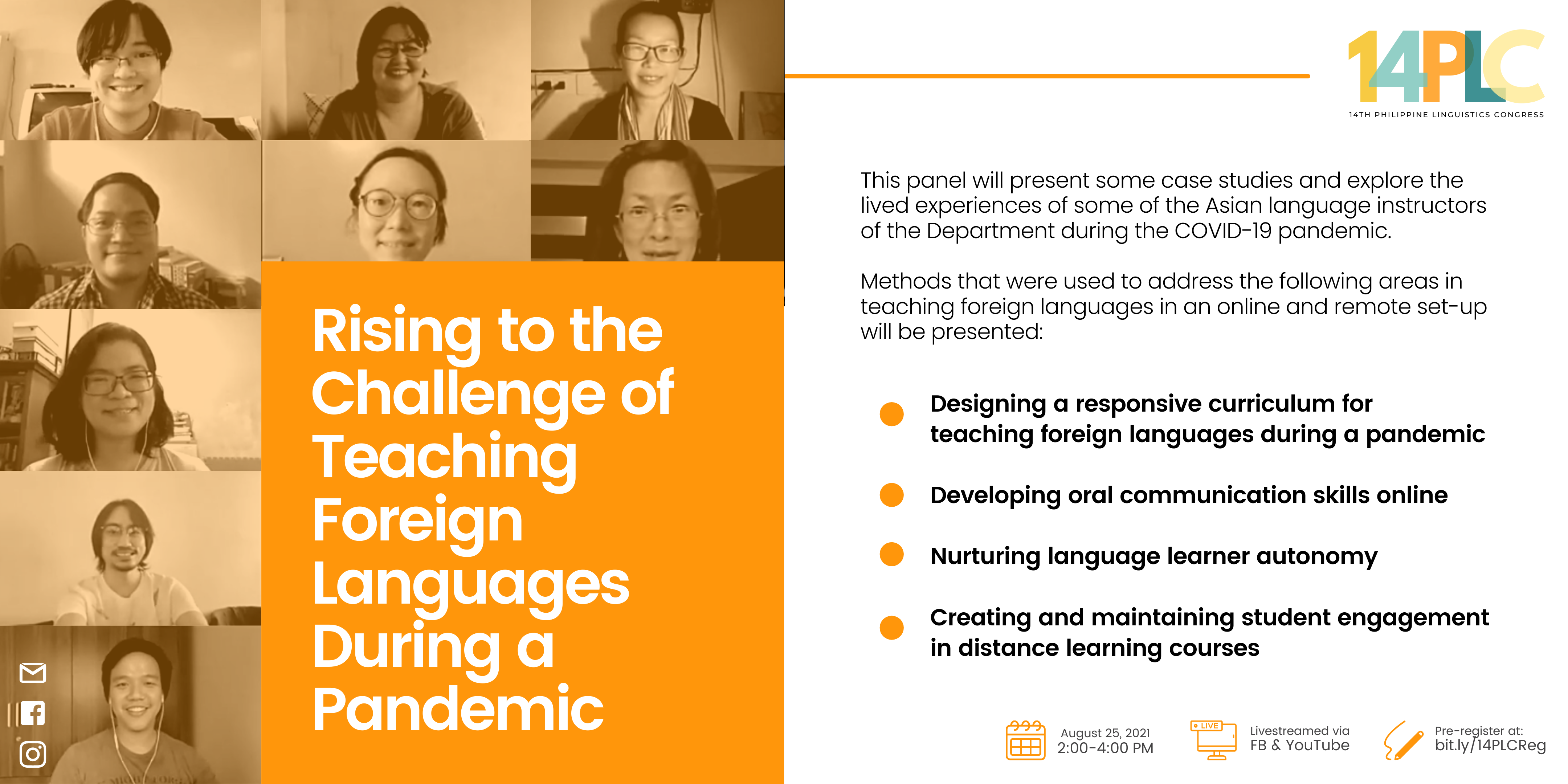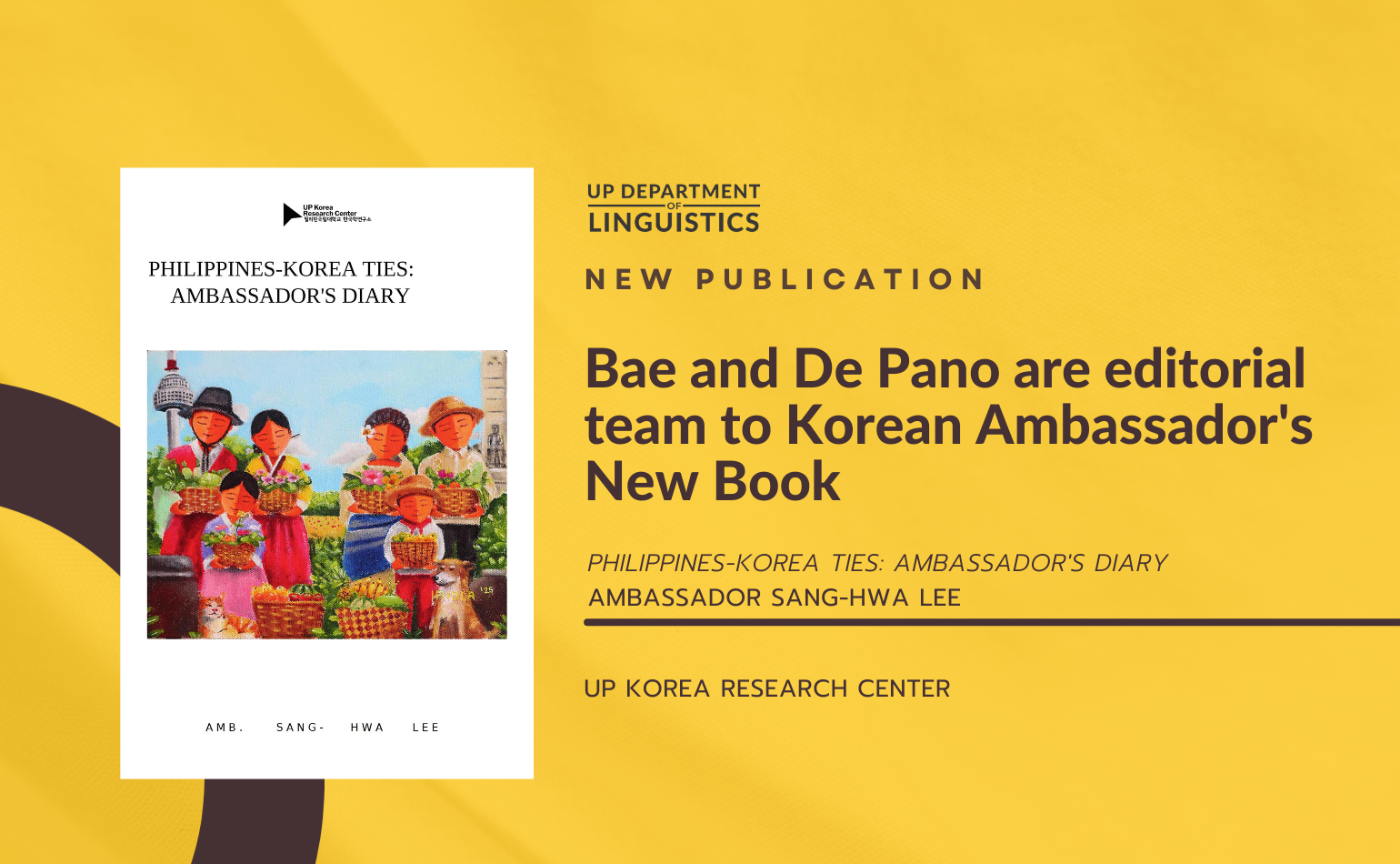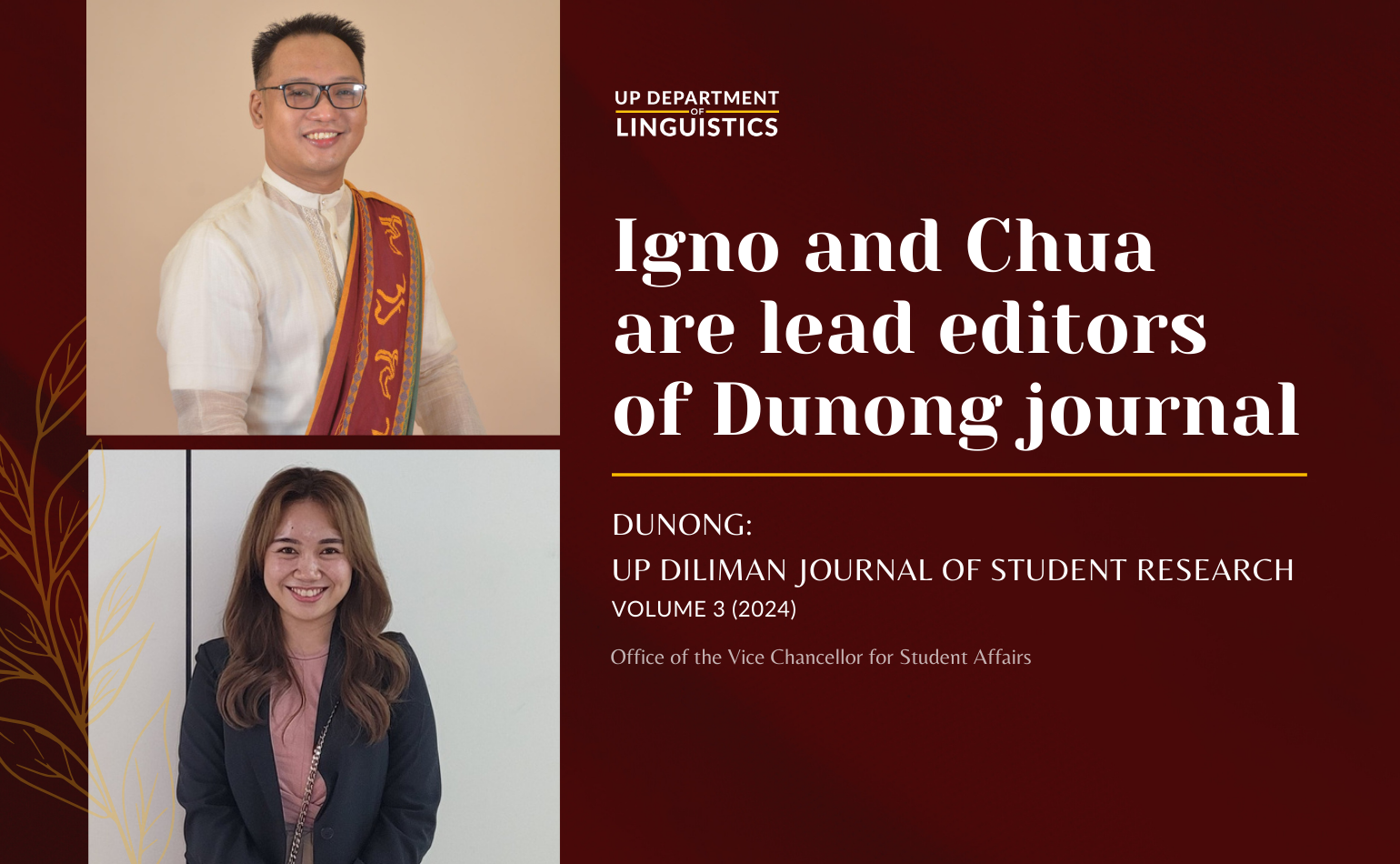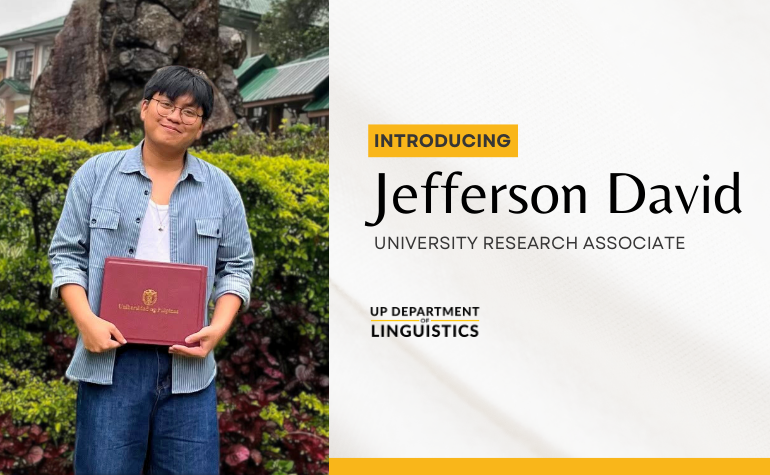
One year since the shift to online and remote learning systems, both teachers and students have encountered various challenges in teaching and learning foreign languages. Held on the 25th of August 2021 during the 14th Philippine Linguistics Congress, the panel “Rising to the Challenge of Teaching Foreign Languages During a Pandemic” presented some case studies and explored the lived experiences of some of the Asian language instructors of the UP Department of Linguistics during the COVID-19 pandemic. Presenters for the panel were Asst. Prof. Farah Cunanan, Asst. Prof. Ria P. Rafael, Asst. Professorial Fellow Kyung Min Bae and Asst. Professorial Fellow Kritsana Athapanyawanit Canilao. The panel was moderated by Asst. Prof. Francisco C. Rosario, Jr. and Asst. Prof. Elsie Marie T. Or.
Designing a Responsive Curriculum
To keep up with the fast-changing world, Cunanan shared the strategies employed by Asian language teachers of the Department for designing a responsive curriculum for teaching foreign languages during a pandemic.
Language teachers were already making use of responsive curricula even before the pandemic through drawing relationships between the local and target cultures and localizing and/or personalizing teaching materials. These practices were continued during the pandemic but were recontextualized and made local and relatable through integrating pandemic-related content. In some classes, vocabulary words and sample sentences relating to hygiene and health protocols were introduced. In others, class content tackled attitudes toward and experiences of the pandemic, like hobbies taken up at this time and nostalgia for the pre-pandemic era. On the other hand, some instructors opted to focus on more positive topics such as talking about well-being and looking forward to a post-COVID world.
Interestingly, some language teachers did not change their curricula substantially. She proposed that this “non-response” vis-a-vis the pandemic serves as a diversion to avoid conflict and emotional triggers such as anxieties, loss, etc. Moreover, many of the mentioned strategies are ideally held during synchronous sessions and may become a burden to students without an ideal online learning setup.
For many language learners, language learning during the pandemic is a coping mechanism—a way to escape reality, to feel productive, or to build up skills. Language teachers also noted that essays written by students are more heartfelt as these became an outlet for them to share their experiences and emotions, just as language in journaling is often used in psychotherapy. Cunanan concluded by quoting Joe Ruhl, “what they’re [students] going to remember most is that you asked them in the hall how they were doing,” emphasizing the importance of care in 21st-century education.
Creating and Maintaining Student Engagement
Motivated by the difficulties she faced in monitoring students, Rafael talked about how language teachers of the Department addressed the issues of creating and maintaining student engagement in a virtual foreign language classroom.
High engagement in students increases focus and motivation in learning. While there are many tools available to a language teacher in promoting engagement, it does not follow that the more activities given to students, the more engaged they are. She proposed that teachers must organize these online activities in a way that would benefit the learners, following Michael Moore’s typology of student interactions.
To promote learner-content interaction in the context of remote learning, content were delivered in different formats such as prerecorded videos or videos from the Internet, presentation slides, podcasts, and the like to cater to students’ varying needs. Learners were also given options on the type of content they engage with and the tasks they perform to attain course goals. As for learner-teacher interaction, language teachers showed strong presence in class and provided consistency as to class sessions and requirements. Moreover, fostering an open communication between the teacher and students also improved student engagement by appealing to people’s need to feel connected. Lastly, focusing on learner-learner interaction, features such as group chats or Zoom breakout rooms allow students to discuss among themselves with or without the teacher present. Likewise, online collaborative tools like Jamboard or social media can be avenues for students to share their outputs and learn from each other.
Rafael stressed that to engage students participating in an online learning environment, connection is essential and educators should make every learner feel that they are not just faces on the screen. Checking in with students does not mean only monitoring their progress towards attaining course objectives but also their presence and personal well-being.
Nurturing Language Learner Autonomy
Having experienced not seeing students’ faces during online synchronous sessions, Bae was not sure how or if students are indeed learning the target language. With this impetus, she shared some insights from the language teachers of the Department on how they were able to nurture language learner autonomy in a remote setup.
The most common motivation of Asian language students is the want to consume cultural content in the target language; such intrinsic motivation is essential for learner autonomy. On the other hand, it may be more difficult for students who listed “requirement for graduation” as a reason for taking language courses to be immersed in the language learning process.
The problems in remote learning language teachers have observed chiefly revolve around the student’s unfamiliarity with modular distance learning and their reliance on both the teacher and the synchronous classes. With this, teachers realized that the goal is to “not just teach the language … rather, make them curious enough about the language that they would want to learn more.” One way of doing so is by providing progress checklists or journal templates where students can reflect not on whether they learned the lesson but on how they were able to grasp the topic and how they felt about learning such. Moreover, flexible curricula and individualized learning goals and establishing a community of language learners and encouraging collaborative learning among students also helps in fostering learner autonomy.
Bae highlights that the end goal of learner autonomy is to instill the independent pursuit of sustainable lifelong learning in our students. Learner autonomy does not simply mean self-study. Students should be aware of the goal of their learning and foster ownership, while teachers need to involve them in reflection, cultivate their confidence, and empower them to apply creative learning strategies.
Developing Oral Communication Skills Online
Canilao discussed how oral communication skills are developed in a remote setup. While oral communication is second nature to native speakers, second or foreign language learners face many difficulties in mastering this competency.
She cited that most language classes in the Department do not put pronunciation practice at the forefront of language learning. Many teachers share the view that pronunciation will be refined as a learner goes through their language learning journey. However, pronunciation—oral communication skills, in general—must be given emphasis as students’ mastery of pronunciation bolsters their confidence in overcoming the language gaps and using the target language in real-life situations. Nevertheless, difficulties faced by both students and teachers in developing oral communication skills online are recognized, including problems with audio-video devices, other technological barriers, lack of nonverbal cues in communication, household environment, and physical and mental health concerns, among others.
One of the expected learning outcomes of all language courses is that at the end of the course, the students can use what they have learned to communicate in various situations and contexts. To achieve such, different tools and strategies may be used. In communicative language teaching, fluency in communication is given primacy over accuracy. Additionally, activities such as dictation tests and tone discrimination exercises (for tonal languages like Thai) with the use of online tools like text-to-speech help in improving students’ listening and speaking skills. Project-based learning activities focusing on oral competency such as audio/video logs, podcasts, and recitations may also be used as a way to put the students’ theoretical learnings into practical use.
Canilao reminds teachers and students alike that “it’s okay to not pronounce it right yet, we’re going to make it together.”
Open Forum
When asked about creating a rubric and grading student essays based on such, Cunanan shared a colleague’s strategy incorporating responsive curriculum and learner autonomy. Instead of setting a singular rubric per activity, the language teacher encourages students to set their own objectives (e.g., use the grammar pattern presented in a specific chapter) and allows them to assess themselves after every activity in terms of how much the students attained the goals they personally set.
With the shift to distance learning, language teachers have limited ways of making sure that students are working on their own and not relying on machine translation applications. Bae addressed this by telling students to not use such applications as machine translations often do not reflect language as used in real life. Such tools may be used as an aid but students must always double check to assure that the output translations accurately communicate what the students intend to convey.
Rafael highlighted the uniqueness of the challenges of teaching foreign languages, especially during a pandemic. A teacher of both linguistics and foreign languages, she takes different approaches in teaching these types of courses. For example, concepts learned in most core courses can easily be applied in daily life and can be taught through asynchronous means. However, the application of foreign languages, especially in beginner-level courses focusing on oral communication skills, is largely confined inside the classroom and is as such often reliant on synchronous sessions and stable internet connection.
Especially in far-flung areas, learner-content interactions serve as the primary learning method of students during the pandemic. Canilao argued that while learner-content interaction only requires a student and a text, it does not necessarily mean that it equates to self-study. In her experiences of teaching students facing internet access problems, the language teacher is also present in learner-content interactions by, first and foremost, providing the primary texts and supplementary materials from which students learn and then following through with making communication channels available for when students have questions or clarifications regarding the topics.
Aside from imparting knowledge of the foreign language, it is also important to build the language learner’s interest in and the confidence that they can learn the target language. While such is already a challenge in the pre-pandemic times, the difficulties in addressing such are compounded. Nevertheless, teachers are becoming more creative in helping students learn foreign languages during the pandemic.
The recording of this online forum can be viewed on our YouTube channel.
_________________________________________________________________________
The UP Department of Linguistics currently offers courses in Asian languages such as Bahasa Indonesia/Malaysia, Chinese Mandarin, Japanese, Korean, Persian (Farsi), and Thai.
Published by James Dominic R. Manrique




